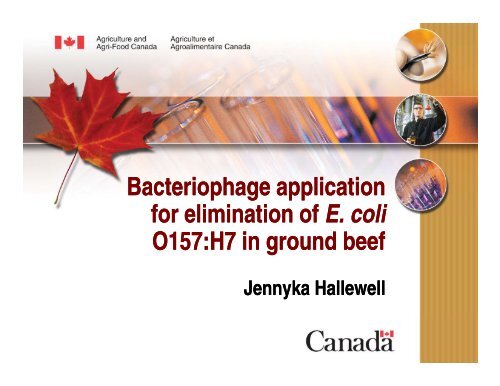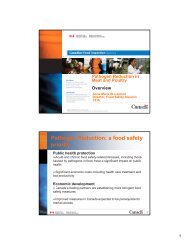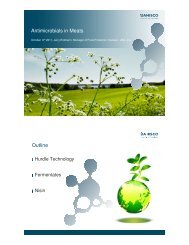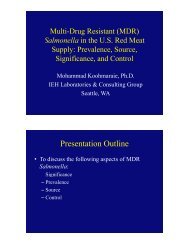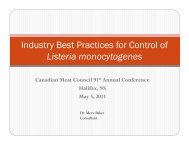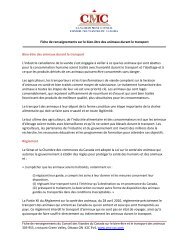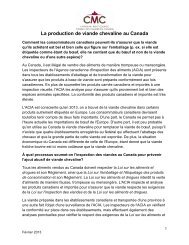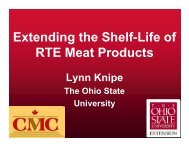Bacteriophage application for elimination of E coli for elimination of ...
Bacteriophage application for elimination of E coli for elimination of ...
Bacteriophage application for elimination of E coli for elimination of ...
Create successful ePaper yourself
Turn your PDF publications into a flip-book with our unique Google optimized e-Paper software.
<strong>Bacteriophage</strong> <strong>application</strong><br />
<strong>for</strong> <strong>elimination</strong> <strong>of</strong> E. <strong>coli</strong><br />
O157:H7 in ground beef<br />
Jennyka Hallewell
• Food and waterborne zoonotic<br />
pathogen<br />
• Initially isolated from Michigan<br />
ground beef outbreak in 1982<br />
• Most commonly isolated serotype<br />
in North America<br />
E. <strong>coli</strong> O157:H7<br />
• Hemorrhagic <strong>coli</strong>tis, Hemolytic<br />
Uremic Syndrome (HUS), death<br />
• Everyone is susceptible (!)<br />
although young and elderly are<br />
high risk
E. <strong>coli</strong> O157:H7 in the feedlot<br />
• Cattle are natural reservoirs <strong>of</strong><br />
E. <strong>coli</strong> O157:H7 and harbour in<br />
feces<br />
• Asymptomatic carriers:<br />
transient and intermittent (10-<br />
100 cfu/g)<br />
• Super shedders (10,000 cfu/g)<br />
• Season, age, weaning,<br />
transport, stress, diet<br />
• The effect <strong>of</strong> feeding Distillers<br />
The effect <strong>of</strong> feeding Distillers<br />
grains to cattle<br />
Environment
Distillers’ Dried Grain with<br />
• By-product <strong>of</strong>f the bioethanol<br />
industry<br />
• DDGS has higher protein, fat and<br />
fibre content than complete grains<br />
and is a valuable feed source <strong>for</strong><br />
cattle<br />
solubles (DDGS)<br />
• Corn DDGS (CDDGS) has been<br />
linked to bovine shedding <strong>of</strong> E.<br />
<strong>coli</strong> O157:H7<br />
• In Canada, DDGS is made<br />
primarily from wheat (WDDGS)<br />
• No studies on WDDGS and fecal<br />
shedding <strong>of</strong> E. <strong>coli</strong> O157:H7
Effect <strong>of</strong> DDGS on E. <strong>coli</strong> O157:H7<br />
in cattle<br />
A. Commercial feedlot study<br />
-Cattle fed finishing diets containing 22.5% CDDGS, WDDGS or CTRL<br />
(n=6,817)<br />
-Collected fecal pats, pH, hide swabs and screened <strong>for</strong> naturally occurring<br />
E. <strong>coli</strong> O157:H7<br />
B. Fecal Persistence study<br />
-Inoculated feces with nalidixic resistance E. <strong>coli</strong> O157:H7 (Nal-R) from cattle<br />
fed 22.5% CDDGS, WDDGS or CTRL<br />
C. Challenge Study<br />
-Inoculated steers with Nal-R E. <strong>coli</strong> O157:H7 (n =32)<br />
-Cattle fed 40% CDDGS, WDDGS, CWDDGS or CTRL<br />
-Collected fecal grabs, pH and screened <strong>for</strong> Nal-R E. <strong>coli</strong> O157:H7
Effect <strong>of</strong> DDGS on E. <strong>coli</strong><br />
O157:H7 in cattle<br />
• Cattle fed CDDGS or WDDGS did not increase fecal shedding or persistence<br />
<strong>of</strong> E. <strong>coli</strong> O157:H7 in feces<br />
• Cattle adapting to finishing diets had enhanced persistence <strong>of</strong> E. <strong>coli</strong> O157:H7<br />
in feces compared to cattle adapted to the diets <strong>for</strong> more than two weeks.<br />
• Many factors may be responsible <strong>for</strong> the variability <strong>of</strong> shedding <strong>of</strong> E. <strong>coli</strong><br />
O157:H7<br />
• Publications<br />
Hallewell,J., McAllister, T.A., Thomas, J., Booker, C. W., Hannon, S., Jim, G. K., Burciaga-Robles, L.O.,<br />
May, M. L., Peterson, R. E., Flaig, C., Hussey, E. M., and K. Stan<strong>for</strong>d. 2012. An evaluation <strong>of</strong> the effects <strong>of</strong><br />
wheat or corn distillers dried grain with solubles on feedlot per<strong>for</strong>mance and fecal shedding and<br />
persistence <strong>of</strong> Escherichia <strong>coli</strong> O157:H7. JAS. Accepted.<br />
Hallewell, J., Barberi, L.R. Thomas, J., Stan<strong>for</strong>d, K. and T. A. McAllister. 2012. Fecal shedding <strong>of</strong><br />
Escherichia <strong>coli</strong> O157:H7 in inoculated cattle fed corn or wheat distillers’ dried grain with solubles. Journal<br />
<strong>of</strong> Food Protection. Submitted.
E. <strong>coli</strong> O157:H7 in ground beef<br />
• Contaminated ground beef has been implicated<br />
as a source <strong>of</strong> multiple E. <strong>coli</strong> O157:H7<br />
outbreaks<br />
• Low infectious dose (~10 cells)<br />
• Large scale production<br />
• Eradication <strong>of</strong> E. <strong>coli</strong> O157:H7 at critical control<br />
points (ie. Grinding and mixing augers) can<br />
prevent mass contamination and massive<br />
recalls<br />
• <strong>Bacteriophage</strong> <strong>application</strong> may provide a<br />
<strong>Bacteriophage</strong> <strong>application</strong> may provide a<br />
natural alternative <strong>for</strong> reduction <strong>of</strong> pathogens in<br />
meat
<strong>Bacteriophage</strong> Application<br />
• <strong>Bacteriophage</strong>s (phages) are natural<br />
predators <strong>of</strong> bacteria including E. <strong>coli</strong><br />
O157:H7<br />
• Viruses (lytic) target specific receptors on<br />
the bacteria, use host machinery to<br />
generate new phage progeny and lyse<br />
host cell releasing new progeny<br />
• Self-replicating, self-limiting, very specific<br />
to targets<br />
• FDA in United States approved phage<br />
preparations p <strong>for</strong> eradication <strong>of</strong> Listeria<br />
monocytogenes<br />
• Phage cocktails can increase specificity<br />
and reduce likelihood <strong>of</strong> resistance<br />
• Phage are ubiquitous in the environment
Isolation <strong>of</strong> Endemic phage from the<br />
environment<br />
• 42 phage isolates were isolated from cattle<br />
feces (SS and CTRL) at the Lethbridge<br />
research center between July and August<br />
2011.<br />
• Phage isolates were screened <strong>for</strong> lytic<br />
activity and purified using E. <strong>coli</strong> O157:H7<br />
host strains.<br />
• Identified highly lytic phage<br />
• Determined Multiplicity <strong>of</strong> Infection (MOI)<br />
• MOI = plaque <strong>for</strong>ming units (pfu) phage<br />
colony <strong>for</strong>ming units (cfu) E. <strong>coli</strong><br />
• Increase titer by infection (propogation)
Multiplicity <strong>of</strong> Infection (MOI)<br />
1400<br />
1200<br />
1000<br />
Titer<br />
pfu/ml (10E E6)<br />
800<br />
600<br />
400<br />
200<br />
0<br />
MOI<br />
Animal 20 Animal 651 Animal 176 Animal 219 Animal 222 Animal 299
Further characterization <strong>of</strong> phages<br />
• 20/42 phage isolates were considered highly lytic to<br />
E. <strong>coli</strong> O157:H7<br />
• Multiplicity <strong>of</strong> Infection (MOI) is unique <strong>for</strong> each phage<br />
• Contact t concentration ti <strong>of</strong> phages with target t is critical<br />
• Allows us to target low numbers <strong>of</strong> E. <strong>coli</strong> O157:H7<br />
found in meat (highly lytic)<br />
• Pulsed Field Gel Electrophoresis (PFGE) (genome<br />
sizing, restriction patterns) to type naturally-occurring<br />
phage and E. <strong>coli</strong> O157:H7 (SS and CTRL animals).
Application <strong>of</strong> phages to meat <strong>for</strong> reduction<br />
<strong>of</strong> E. <strong>coli</strong> O157:H7<br />
• Highly virulent phages cocktails will be applied to ground beef to reduce E. <strong>coli</strong><br />
O157:H7.<br />
• Ground beef samples will be inoculated with Nal-R E. <strong>coli</strong> O157:H7 and<br />
screened <strong>for</strong> E. <strong>coli</strong> O157:H7 and phage.<br />
• The effects <strong>of</strong> mixing, temperature, and level <strong>of</strong> contamination will be<br />
investigated.<br />
• Results from this study will allow us to assess the possibility <strong>of</strong> phage<br />
<strong>application</strong> at critical control points such during processing <strong>for</strong> eradication <strong>of</strong> E.<br />
<strong>coli</strong> O157:H7 post-slaughter<br />
• Characterization <strong>of</strong> naturally occurring phage in the environment will contribute<br />
to limited knowledge <strong>of</strong> vast populations <strong>of</strong> phages and accelerate progress to<br />
many new exciting <strong>application</strong>s!<br />
12
Acknowledgements<br />
T. A. McAllister, R. Barbieri, K. Munns, L. Selinger<br />
Agriculture and Agri-Food Canada<br />
K. Stan<strong>for</strong>d, C. Agopsowicz, Y. Han, J. Peters,<br />
H. Zhahiroddini, G. Wallins<br />
Alberta Agriculture and Rural Development<br />
C.W. Booker, S. Hannon, G. Jim, L. Burciaga-Robles Robles, M.L. May,<br />
R.E. Peterson, C. Flaig, E.M. Hussey<br />
Feedlot Health Management Services<br />
J. Thomas, B. Selinger, S. Wetmore<br />
University <strong>of</strong> Lethbridge
Thank You!


